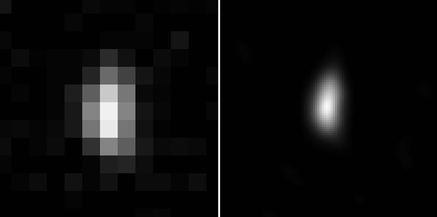Sometimes we must wander very far to learn something fundamental about ourselves. Today’s Fly-by of “Ultima Thule” lets us gaze, in detail, at the most distant planetary object our eyes have ever seen. Yes, it’s a first for all of humanity and it’s happening on the first day of this new year 2019. To me, that’s reason enough to put down a few words in recognition.

NASA’s New Horizons probe swooped by the Kuiper Belt object 2014 MU69, als known as "Ultima Thule", this morning at 06:33 CET. Just shortly before I woke up and started this entry. Don’t get too excited now, the signal carrying those long awaited first images hasn’t reached our planet yet. As I write, it is beaming towards Earth’s largest antennas at light speed.
It takes a little over six hours for the signal to cover the more than 6.6 billion kilometres to get here. Yup, billion. In easier numbers, that’s 44.26 times the distance from Earth to Sun (one astronomical unit or AU), over 17,000 times the distance to the moon and almost 1,2 million times London to New York.
New Horizons is one hell of a little firecracker. The robotic space traveler left Earth 12 years ago and has broken several astounding records. The most memorable moment so far was the Pluto Fly-by in 2015. Here’s the link to those images while you wait for the new ones.
Why the Kuiper Belt?
Like Pluto, “Ultima Thule” is located in the Kuiper Belt. The gigantic disc of icy matter begins just behind Neptune’s orbit at 30 AU. Its outer regions extend to nearly 1,000 AU. So far, astronomers have discovered and named roughly 2,000 Kuiper Belt objects or "KBOs". They estimate there are hundreds of thousands more, at least 100 kilometres wide. Ultima Thule itself is only about 30km wide and belongs to a group of KBOs that have not been disturbed since the time of the solar system’s formation. This is why it’s so special: studying it is like taking a time machine 4.6 billion years into the past.
But not just that. By studying the Kuiper Belt in such detail, human space exploration is also crossing over into a new realm of understanding and pushing some of our solar system’s complexity into public mainstream knowledge. The upcoming images are going to be iconic.
With this in mind, I wish you all a very Happy New Year and hope it continues to be as promising as it is beginning for all of us. Don’t forget to keep an eye out for those first images later today and tomorrow. If you want to witness the action live, NASA will be streaming the signal acquisition from 15:45 CET here today.

Kommentar schreiben